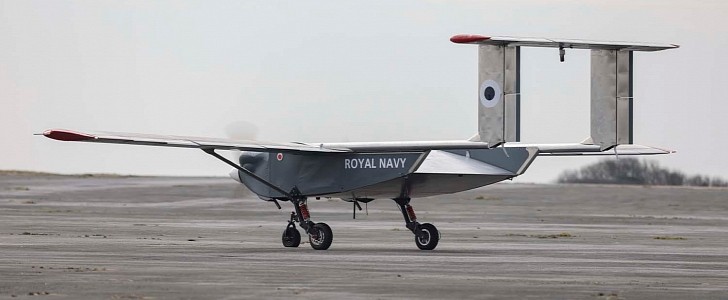The Royal Navy has been testing uncrewed aircraft's capabilities of delivering heavy payloads in different environments with the goal of using the tech on front-line operations. The Navy's drone experts collaborated with two companies and pushed the drones to their limits.
This is the second time the systems are being tested. Last year, the Royal Navy demonstrated how they could be used in various operations. Now, drone specialists from the Navy's 700X Naval Air Squadron have invited industry partners to RNAS Culdrose to put two crewless aircraft through their paces.
This series of trials was more intense and included a Malloy T-600 quadcopter and an ULTRA drone. As part of the Heavy Lift Challenge, both Malloy and Windracers were awarded a £300,000 (~ $391,500) contract to continue the development of their drones.
The Heavy Lift Challenge is a collaboration between 700X, the Navy's Office of the Chief Technology Officer, and Defence Equipment and Support's (DE&S) Future Capability Group, and it focuses on rapidly increasing the number of uncrewed aircraft systems (UAS) on the market.
It also invites industry partners to explore what UAS they have that could be converted to be used by the Royal Navy to carry humanitarian supplies, first aid, ammunition, and other crucial payloads to the front line.
During the recent tests, both aircraft demonstrated their heavy-lift capabilities. The Malloy T-600 carried a cargo of 250 kg (575 lbs), while the fixed-wing ULTRA flew for 1,000 km (621 miles) to drop a payload of 100 kg (220 lbs) on a platform that resembled the flight deck of a Queen Elizabeth-class aircraft carrier. The drone was able to drop the payload with incredible accuracy.
The data obtained during the trials will be used by the Navy and DE&S to develop autonomous systems capable of delivering heavy payloads in a different set of environments.
Brigadier Dan Cheesman, Royal Navy Chief Technology Officer, said: "We are not there quite yet, but in perhaps as little as two months' time, we will have the final 'show don't tell' evidence we need to commence scaling to the hands of the warfighter at unprecedented pace."
This series of trials was more intense and included a Malloy T-600 quadcopter and an ULTRA drone. As part of the Heavy Lift Challenge, both Malloy and Windracers were awarded a £300,000 (~ $391,500) contract to continue the development of their drones.
The Heavy Lift Challenge is a collaboration between 700X, the Navy's Office of the Chief Technology Officer, and Defence Equipment and Support's (DE&S) Future Capability Group, and it focuses on rapidly increasing the number of uncrewed aircraft systems (UAS) on the market.
It also invites industry partners to explore what UAS they have that could be converted to be used by the Royal Navy to carry humanitarian supplies, first aid, ammunition, and other crucial payloads to the front line.
During the recent tests, both aircraft demonstrated their heavy-lift capabilities. The Malloy T-600 carried a cargo of 250 kg (575 lbs), while the fixed-wing ULTRA flew for 1,000 km (621 miles) to drop a payload of 100 kg (220 lbs) on a platform that resembled the flight deck of a Queen Elizabeth-class aircraft carrier. The drone was able to drop the payload with incredible accuracy.
The data obtained during the trials will be used by the Navy and DE&S to develop autonomous systems capable of delivering heavy payloads in a different set of environments.
Brigadier Dan Cheesman, Royal Navy Chief Technology Officer, said: "We are not there quite yet, but in perhaps as little as two months' time, we will have the final 'show don't tell' evidence we need to commence scaling to the hands of the warfighter at unprecedented pace."
The #RoyalNavy has been trialling the use of drones to deliver supplies, with the aim of using autonomous technology on front-line operations. Two companies worked with the navy's drone experts #700XNAS to put two uncrewed aircraft through their paces.
— Royal Navy (@RoyalNavy) April 6, 2022
????https://t.co/Hsj3PdYX4i pic.twitter.com/naJGeG8hsg







